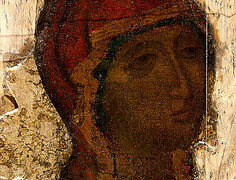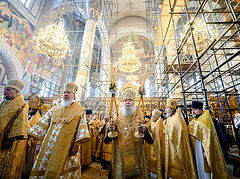Kommuna Pchela, Bryansk Province, Russia, November 13, 2024
On November 4, the feast of the Kazan Icon of the Mother of God, the Theotokos Ploschanskaya Hermitage celebrated both the 30th anniversary of its revival and the return of its ancient copy of the Kazan Icon.
The icon was previously housed at the 17th-century monastery until its closure in 1924, reports the Russian Church’s Department for Monasteries and Monasticism.
After the service, the icon was presented to His Eminence Metropolitan Alexander of Bryansk by Moscow resident Natalia Lazareva, who discovered it in an antique shop in a Moscow suburb.
“The icon was very dark, with damage, and the nose on the Mother of God’s face was gouged out, as if struck with an axe or knife. I'm an architect and also work in icon restoration, and I wanted to restore it,” Natalia explains.
The shop owner gifted her the icon, and its restoration took four months. The icon is dated to the late 18th-early 19th century.
“The return of a holy object, especially an ancient one, is a significant event—it’s a connection across time, particularly after the desecration and destruction of the church in the 20th century, and it’s a blessing from the Mother of God for the development of monastic life. The Theotokos thereby shows that she ceaselessly remains with us and covers us with Her maternal omophorion, so all the difficulties and vicissitudes of life are experienced in a completely different way,” said Abbot Leonid (Lushkin) of the Theotokos Ploshchanskaya Hermitage.
***
The monastery’s history spans several centuries of dramatic changes. The original monastery was destroyed during Russia’s Time of Troubles in the early 1600s. Its revival began between 1613 and 1620 under the leadership of Hieromonk Prokopy, who traveled from the Kiev Caves Lavra to rebuild the sacred site. The monastery received crucial support from Tsar Michael Romanov, who granted it extensive lands and donated two precious icons from his royal chambers.
Over the following centuries, it flourished and developed, eventually becoming one of the most well-established monasteries in Russia by the early 20th century. The monastery was known for its strict monastic rule and high spiritual life. Before the revolution, it was a major spiritual and cultural center in Russia, with extensive facilities including guest houses, workshops, mills, and agricultural operations.
However, like many religious institutions, it faced severe persecution after the Russian Revolution, being closed and thoroughly looted by Soviet authorities in 1924. The monastery grounds were subsequently converted into a commune.
Further destruction came in 1962 when authorities attempted to demolish its cathedral, though the structure partially survived the explosion. After the fall of the Soviet Union, the monastery was finally returned to the Russian Orthodox Church in 1994, and since then has been undergoing a gradual process of restoration.
Follow OrthoChristian on Twitter, Vkontakte, Telegram, WhatsApp, MeWe, and Gab!






